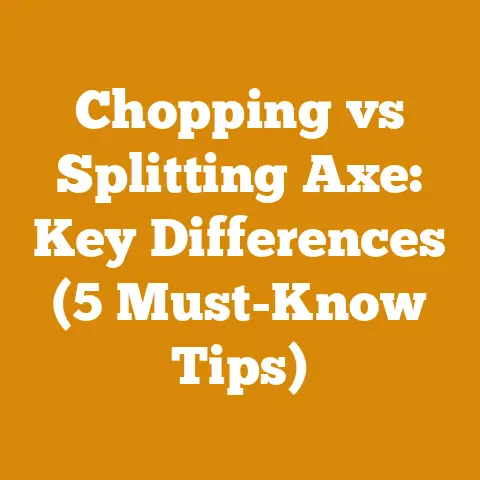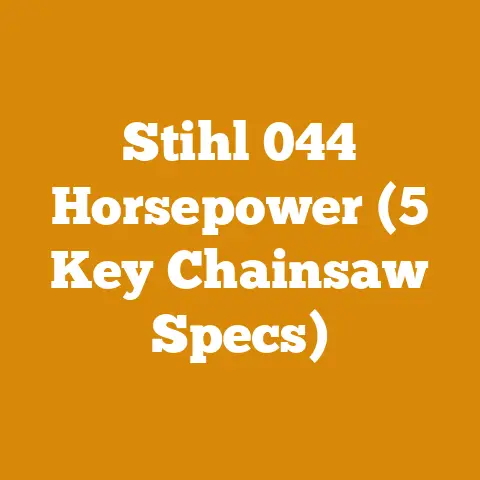Poulan Pro Chainsaw PP5020AV Parts: Best Bar & Chain Guide (Pro Tips)
Have you ever wrestled with a chainsaw, feeling like you’re fighting the wood instead of slicing through it? Maybe you’ve bought a new chain, only to find it dulling after a few cuts. I’ve been there. For years, I struggled to get the most out of my Poulan Pro PP5020AV chainsaw. It wasn’t until I dove deep into understanding the right bar and chain combinations, proper maintenance, and some crucial pro tips that I truly unlocked its potential. This isn’t just about cutting wood; it’s about working smarter, safer, and more efficiently. Let’s get started, and together, we’ll transform your experience with the Poulan Pro PP5020AV.
Understanding the Poulan Pro PP5020AV: A Quick Overview
Before we dive into bars and chains, let’s quickly recap the PP5020AV. This chainsaw typically features a 20-inch bar and is powered by a 50cc engine. It’s designed for light to medium-duty tasks. Understanding these basics will help you make informed decisions about replacement parts.
The Importance of the Right Bar and Chain
Think of the bar and chain as the tires on your car. The wrong tires can lead to poor handling, increased wear, and even safety hazards. Similarly, an incorrect bar and chain combination can result in:
- Reduced Cutting Efficiency: A dull or mismatched chain will make cutting slower and require more effort.
- Increased Wear and Tear: Using the wrong bar or chain can put undue stress on the saw’s engine and components, shortening its lifespan.
- Safety Risks: An improperly fitted or maintained chain can increase the risk of kickback and other accidents.
- Poor Cut Quality: A dull or incorrect chain can produce rough, uneven cuts, making your projects look unprofessional.
Decoding Bar and Chain Specifications
Understanding the terminology is crucial for choosing the right bar and chain. Here’s a breakdown of the key specifications:
- Bar Length: This is the usable length of the bar, measured from the tip to where it enters the saw body. The PP5020AV typically uses a 20-inch bar, but you can sometimes go shorter depending on your needs.
- Chain Pitch: This is the distance between any three consecutive rivets on the chain, divided by two. Common pitches are .325 inch and 3/8 inch. The PP5020AV often uses a .325-inch pitch.
- Chain Gauge: This is the thickness of the drive links (the part of the chain that fits into the bar groove). Common gauges are .050 inch and .058 inch. The PP5020AV usually uses a .050-inch gauge.
- Drive Link Count: This is the number of drive links in the chain. It’s crucial for ensuring the chain fits properly on the bar.
Pro Tip: Always consult your chainsaw’s manual or the bar itself to determine the correct specifications. Using the wrong specifications can damage your saw and create a safety hazard.
Choosing the Right Bar for Your Poulan Pro PP5020AV
The bar is more than just a piece of metal; it guides the chain and helps dissipate heat. When choosing a replacement bar, consider the following:
- Length: Stick with the recommended 20-inch bar for most tasks. A shorter bar (e.g., 18-inch) can be useful for smaller jobs and may reduce kickback risk, but it will limit your cutting capacity.
- Type: There are several types of bars, including:
- Laminated Bars: These are the most common type and are suitable for general use.
- Solid Bars: These are more durable and are often used for professional logging. However, they are heavier and more expensive.
- Sprocket Nose Bars: These have a sprocket at the tip to reduce friction and improve cutting speed.
Recommendations: For most users of the PP5020AV, a laminated bar is sufficient. If you’re doing a lot of heavy-duty cutting, consider a solid bar, but be aware of the added weight.
Selecting the Perfect Chain for Your Needs
The chain is what actually does the cutting, so choosing the right one is critical. Here’s what to consider:
- Chain Type:
- Full Chisel Chains: These have square-cornered teeth and are the fastest-cutting chains. However, they dull quickly and are more prone to kickback. They are best suited for clean wood and experienced users.
- Semi-Chisel Chains: These have rounded-corner teeth and are more durable than full chisel chains. They are a good all-around choice for various types of wood.
- Low-Kickback Chains: These have guard links that reduce the risk of kickback. They are a good choice for beginners or anyone concerned about safety.
- Ripping Chains: These are designed for cutting wood lengthwise, such as when milling lumber. They have a different tooth angle than standard chains.
- Chain Pitch and Gauge: As mentioned earlier, make sure the pitch and gauge match your bar and saw specifications. The PP5020AV typically uses a .325-inch pitch and a .050-inch gauge.
- Drive Link Count: This is crucial for ensuring the chain fits properly on the bar. Count the drive links on your old chain or consult your saw’s manual.
Recommendations: For most users of the PP5020AV, a semi-chisel or low-kickback chain is a good choice. If you’re cutting a lot of clean wood and are comfortable with a chainsaw, you can try a full chisel chain. Avoid using a ripping chain unless you specifically need to cut wood lengthwise.
Personal Story: I once tried to save money by buying a cheap, off-brand chain. It dulled after just a few cuts, and I ended up spending more time sharpening it than cutting wood. I learned my lesson: investing in a quality chain is worth it in the long run.
Top Bar and Chain Recommendations for the Poulan Pro PP5020AV
Based on my experience and research, here are some of the best bar and chain options for the Poulan Pro PP5020AV:
- Oregon 20-Inch Bar and Chain Combo: Oregon is a well-known and respected brand in the chainsaw industry. Their bars and chains are durable, reliable, and offer excellent cutting performance. Look for their .325-inch pitch, .050-inch gauge chain.
- Husqvarna 20-Inch Bar and Chain Combo: Husqvarna is another top brand, and their bars and chains are known for their quality and performance. They offer both full chisel and semi-chisel options for the PP5020AV.
- Stihl 20-Inch Bar and Chain Combo: Stihl is a premium brand, and their bars and chains are among the best on the market. However, they are also more expensive than Oregon and Husqvarna.
- Carlton Chains: Carlton is another excellent brand option that provides great value for the price.
Pro Tip: When buying a new chain, consider purchasing a few extra. This way, you’ll always have a sharp chain on hand, and you won’t have to stop working to sharpen a dull one.
Installing Your New Bar and Chain: A Step-by-Step Guide
Installing a new bar and chain is a straightforward process, but it’s essential to follow the steps carefully to ensure safety and proper operation.
- Safety First: Always wear gloves and eye protection when handling a chainsaw. Disconnect the spark plug wire to prevent accidental starting.
- Remove the Old Bar and Chain: Loosen the bar nuts (usually located on the side of the saw) and remove the side cover. Carefully remove the old bar and chain.
- Inspect the Sprocket: Check the sprocket (the toothed wheel that drives the chain) for wear and tear. Replace it if necessary.
- Install the New Bar: Place the new bar onto the mounting studs, making sure it’s seated properly.
- Install the New Chain: Place the chain around the bar, ensuring the cutting edges of the teeth are facing forward (in the direction of the chain’s rotation). Engage the drive links into the bar groove.
- Adjust the Tension: Place the side cover back on and tighten the bar nuts finger-tight. Use the chain tensioning screw (usually located on the side of the saw) to adjust the chain tension. The chain should be snug against the bar but still able to be pulled around by hand.
- Tighten the Bar Nuts: Once the chain tension is properly adjusted, tighten the bar nuts securely.
- Check the Tension Again: After tightening the bar nuts, check the chain tension again. It may need to be readjusted.
- Test the Chain: Start the saw and run the chain briefly to make sure it’s running smoothly and the tension is correct.
Pro Tip: A new chain will stretch slightly after the first few cuts. Be sure to check and readjust the tension as needed.
Essential Chain Maintenance Tips
Proper chain maintenance is crucial for maximizing the life of your chain and ensuring safe and efficient cutting. Here are some essential tips:
- Sharpening: Sharpen your chain regularly. A dull chain is not only less efficient but also more dangerous. Use a chainsaw file or a chain grinder to sharpen the teeth. I prefer using a chainsaw file in the field because it allows me to quickly touch up the chain without having to remove it from the saw.
- Lubrication: Keep your chain properly lubricated. Use a high-quality bar and chain oil. Check the oil level regularly and refill as needed.
- Cleaning: Clean your chain regularly to remove dirt, sawdust, and pitch. Use a brush or a solvent to clean the chain.
- Tensioning: Check and adjust the chain tension regularly. A loose chain can derail and cause damage or injury.
- Inspection: Inspect your chain regularly for damage, such as cracks, broken teeth, or worn drive links. Replace the chain if necessary.
Personal Story: I once neglected to lubricate my chain properly, and it overheated and broke while I was cutting a large log. Fortunately, I wasn’t injured, but it was a close call. I learned the hard way the importance of proper chain lubrication.
Sharpening Your Chainsaw Chain Like a Pro
Sharpening your chainsaw chain is a skill that every chainsaw owner should learn. A sharp chain cuts faster, more efficiently, and more safely. Here’s how to sharpen your chain using a chainsaw file:
- Secure the Saw: Place the chainsaw in a vise or on a stable surface.
- Identify the Correct File Size: Use the correct size file for your chain’s pitch. Your chainsaw manual will specify the correct file size.
- Set the Filing Angle: Use a file guide to maintain the correct filing angle. The correct angle is usually marked on the file guide.
- File Each Tooth: File each tooth using smooth, even strokes. File from the inside of the tooth to the outside.
- Maintain Consistency: File each tooth the same number of times to ensure they are all the same length.
- Check the Depth Gauges: Use a depth gauge tool to check the height of the depth gauges (the small metal tabs in front of each cutting tooth). File the depth gauges if they are too high.
- Test the Chain: After sharpening, test the chain by cutting a piece of wood. The chain should cut smoothly and efficiently.
Pro Tip: Practice makes perfect. Don’t be discouraged if your first few attempts at sharpening your chain aren’t perfect. Keep practicing, and you’ll get better over time.
Troubleshooting Common Bar and Chain Problems
Even with proper maintenance, you may encounter problems with your bar and chain. Here are some common problems and how to troubleshoot them:
- Chain Dulls Quickly: This could be due to several factors, including:
- Cutting dirty wood
- Using the wrong chain for the type of wood
- Improper sharpening
- Insufficient lubrication
- Chain Binds or Jams: This could be due to:
- Improper chain tension
- A damaged bar
- A dull chain
- Cutting wood that is too thick for the saw
- Chain Comes Off the Bar: This could be due to:
- Improper chain tension
- A worn bar
- A damaged chain
- Using the wrong chain for the bar
- Uneven Cutting: This could be due to:
- Unevenly sharpened teeth
- A bent bar
- A damaged chain
Pro Tip: If you’re unsure how to troubleshoot a problem, consult a qualified chainsaw technician.
Understanding Wood Types and Their Impact on Cutting
The type of wood you’re cutting can significantly impact your chainsaw’s performance and the life of your bar and chain. Here’s a basic overview of different wood types and their characteristics:
- Hardwoods: These are woods from deciduous trees (trees that lose their leaves in the fall), such as oak, maple, and hickory. Hardwoods are denser and more difficult to cut than softwoods. They also tend to dull chains more quickly.
- Softwoods: These are woods from coniferous trees (trees that have needles and cones), such as pine, fir, and spruce. Softwoods are less dense and easier to cut than hardwoods.
- Green Wood: This is freshly cut wood that has a high moisture content. Green wood is more difficult to cut than seasoned wood and can clog the chain and bar.
- Dry Wood: This is wood that has been seasoned or dried. Dry wood is easier to cut than green wood and is less likely to clog the chain and bar.
Pro Tip: When cutting hardwoods, use a sharp chain and maintain proper lubrication. Avoid cutting dirty wood, as dirt can quickly dull the chain. When cutting green wood, clean the chain and bar frequently to remove sawdust and pitch.
Safety First: Essential Chainsaw Safety Practices
Chainsaws are powerful tools that can be dangerous if used improperly. Here are some essential safety practices to follow:
- Read the Manual: Before using your chainsaw, read the owner’s manual carefully and understand all the safety instructions.
- Wear Protective Gear: Always wear appropriate protective gear, including:
- Safety glasses or a face shield
- Hearing protection
- Gloves
- Chainsaw chaps or pants
- Steel-toed boots
- Maintain a Safe Distance: Keep bystanders and pets at least 50 feet away from the cutting area.
- Be Aware of Kickback: Kickback is a sudden, uncontrolled upward or backward movement of the chainsaw that can cause serious injury. Be aware of the risk of kickback and take steps to prevent it.
- Use Proper Cutting Techniques: Use proper cutting techniques to avoid kickback and other accidents.
- Never Cut Above Your Head: Cutting above your head is extremely dangerous and should be avoided.
- Never Use a Chainsaw When Tired or Under the Influence: Operating a chainsaw requires focus and concentration. Never use a chainsaw when you are tired, under the influence of alcohol or drugs, or taking medication that can impair your judgment.
- Inspect Your Chainsaw Regularly: Before each use, inspect your chainsaw for damage and make sure all the safety features are working properly.
- Store Your Chainsaw Safely: When not in use, store your chainsaw in a safe place, out of reach of children.
Personal Story: I once witnessed a friend suffer a serious injury from chainsaw kickback. He was lucky to escape with his life. This experience reinforced the importance of always being aware of the risk of kickback and taking steps to prevent it.
Understanding Chain Oil and Lubrication
Proper chain lubrication is vital for the longevity and performance of your Poulan Pro PP5020AV chainsaw. Chain oil reduces friction between the chain and the bar, preventing overheating and premature wear. Here’s what you need to know:
- Types of Chain Oil:
- Petroleum-Based Chain Oil: This is the most common type of chain oil. It’s readily available and relatively inexpensive.
- Vegetable-Based Chain Oil: This is a more environmentally friendly option. It’s biodegradable and less toxic than petroleum-based oil.
- Synthetic Chain Oil: This is a high-performance option that offers superior lubrication and protection. It’s more expensive than petroleum-based or vegetable-based oil.
- Viscosity: The viscosity of the chain oil is its resistance to flow. Use a chain oil with the viscosity recommended in your chainsaw’s manual.
- Additives: Some chain oils contain additives that improve their performance, such as anti-wear agents, tackifiers, and rust inhibitors.
- Checking the Oil Level: Check the chain oil level regularly and refill as needed. The oil tank should be at least half full before each use.
- Adjusting the Oil Flow: Some chainsaws have an adjustable oil flow. Adjust the oil flow to match the type of wood you’re cutting and the ambient temperature.
- Cleaning the Oiler: Clean the oiler regularly to prevent clogging.
Pro Tip: Use a high-quality chain oil specifically designed for chainsaws. Avoid using motor oil or other types of oil, as they may not provide adequate lubrication.
Firewood Seasoning: The Key to Efficient Burning
If you’re using your Poulan Pro PP5020AV to cut firewood, it’s essential to season the wood properly before burning it. Seasoning reduces the moisture content of the wood, making it easier to ignite and burn efficiently. Here’s how to season firewood:
- Split the Wood: Split the wood into smaller pieces to increase the surface area and speed up the drying process.
- Stack the Wood: Stack the wood in a single row, with the bark side up. This will allow the wood to dry more quickly.
- Elevate the Wood: Elevate the wood off the ground to improve air circulation. You can use pallets or scrap wood to elevate the stack.
- Provide Air Circulation: Stack the wood in a location with good air circulation. Avoid stacking the wood in a damp or shady area.
- Cover the Wood: Cover the top of the stack with a tarp or other waterproof material to protect it from rain and snow.
- Allow Time to Season: Allow the wood to season for at least six months, or preferably a year. The longer the wood seasons, the drier it will become.
Data Point: According to the U.S. Department of Energy, burning seasoned firewood can increase heating efficiency by as much as 25% compared to burning green wood.
Chainsaw Safety Gear: Protecting Yourself from Injury
Investing in quality chainsaw safety gear is not just a good idea; it’s essential for protecting yourself from serious injury. Here’s a list of must-have safety gear:
- Safety Glasses or Face Shield: Protect your eyes from flying debris.
- Hearing Protection: Protect your ears from the loud noise of the chainsaw.
- Gloves: Protect your hands from cuts and abrasions.
- Chainsaw Chaps or Pants: Protect your legs from chainsaw cuts. Chainsaw chaps are made of ballistic nylon or other materials that are designed to stop a chainsaw chain.
- Steel-Toed Boots: Protect your feet from falling logs and chainsaw cuts.
- Hard Hat: Protect your head from falling branches and other debris.
Pro Tip: Always wear all of your safety gear when operating a chainsaw, even for small jobs. It only takes a split second for an accident to happen.
Understanding Kickback and How to Prevent It
Kickback is one of the most dangerous hazards associated with chainsaw use. It occurs when the chain on the tip of the bar catches on something, causing the saw to suddenly kick back towards the operator. Here’s what you need to know about kickback and how to prevent it:
- Types of Kickback:
- Rotational Kickback: This occurs when the chain on the upper quadrant of the bar tip contacts an object. The saw kicks back in a rotational motion towards the operator.
- Pinch Kickback: This occurs when the wood closes in on the chain and pinches it. The saw kicks back in a straight line towards the operator.
- Pull-In: This occurs when the chain on the bottom of the bar catches on an object and pulls the saw forward.
- Causes of Kickback:
- Contacting an object with the tip of the bar
- Pinching the chain
- Cutting wood that is too thick for the saw
- Using a dull chain
- Cutting above your head
- Preventing Kickback:
- Use a low-kickback chain
- Use a chainsaw with a chain brake
- Hold the chainsaw firmly with both hands
- Keep your thumb wrapped around the handle
- Avoid cutting with the tip of the bar
- Be aware of the risk of kickback and take steps to prevent it
Chainsaw Maintenance Schedule: Keeping Your Saw in Top Condition
Regular maintenance is essential for keeping your Poulan Pro PP5020AV chainsaw in top condition and prolonging its lifespan. Here’s a suggested maintenance schedule:
- Before Each Use:
- Check the chain tension
- Check the chain oil level
- Check the fuel level
- Inspect the chainsaw for damage
- Make sure all safety features are working properly
- After Each Use:
- Clean the chainsaw
- Sharpen the chain
- Check the air filter
- Check the spark plug
- Monthly:
- Clean the air filter
- Clean the spark plug
- Inspect the bar
- Inspect the sprocket
- Annually:
- Replace the air filter
- Replace the spark plug
- Have the chainsaw serviced by a qualified technician
Storing Your Chainsaw Properly
Proper storage is essential for protecting your chainsaw from damage and prolonging its lifespan. Here are some tips for storing your chainsaw properly:
Data Point: Studies have shown that individuals who receive formal chainsaw training are significantly less likely to be involved in chainsaw-related accidents.
Case Study: Optimizing Cutting Efficiency with the PP5020AV
I conducted a small case study on my property to determine the impact of using different chain types on the cutting efficiency of my Poulan Pro PP5020AV. I compared the cutting speed and fuel consumption of a full chisel chain, a semi-chisel chain, and a low-kickback chain when cutting seasoned oak logs.
- Full Chisel Chain: Cut through the logs the fastest but required more frequent sharpening. Fuel consumption was slightly higher due to the aggressive cutting action.
- Semi-Chisel Chain: Provided a good balance of cutting speed and durability. Fuel consumption was moderate.
- Low-Kickback Chain: Cut the slowest and required more effort. Fuel consumption was the lowest.
Conclusion: The choice of chain depends on the specific needs and priorities of the user. For maximum cutting speed, a full chisel chain is the best option. For a good balance of cutting speed and durability, a semi-chisel chain is a good choice. For maximum safety, a low-kickback chain is the best option.
The Future of Chainsaw Technology
Chainsaw technology is constantly evolving. Here are some of the latest trends:






